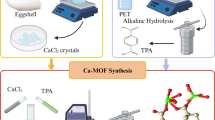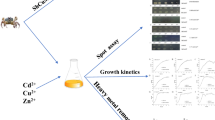Abstract
Amino acid sequences in metal-binding proteins with chelating properties offer exciting applications in biotechnology and medical research. To enhance their application in bioremediation studies, we explicitly aimed to identify specific metal-binding chelating motifs in protein structures for two significant pollutants, such as mercury (Hg2+) and chromium Cr(V1). For this purpose, we have performed an extensive coordination chemistry approach by retrieving Hg2+ and Cr(V1) binding protein structures from the protein database and validated using the B-factor, a term defining uncertainty of the atoms and with occupancy to obtain the best binding motifs. Our analysis revealed that acidic amino acids like aspartic acid, glutamic acid, and basic amino acids such as cysteine and histidine are predominant in coordinating with these metals. The order of preference in Hg2+-bound structures is predicted to be Cys > His > Asp > Glu, and for Cr(V1) is His > Asp > Glu. Examination of the atomic coordinates and their distance from each metal revealed that the sulfur atoms of cysteine showing more preference towards Hg2+coordination with an atomic distance ranging from 1.5 to 2.9 Å. Likewise, oxygen atoms of aspartic acid, glutamic acid and nitrogen atoms of histidine are within 2 Å of Cr(V1) coordination. Based on these observations, we obtained C–C–C, C-X(2)-C–C-(X)2-C, H–C–H motifs for Hg2+, and D-X(1)-D, H-X(3)-E motif for Cr(V1) to be shared within the coordination space of 3 Å. As a future scope, we propose that the identified metal-binding chelating motifs are oligopeptides and can display on the surface of microorganisms such as Escherichia coli and Saccharomyces cerevisiae for effective removal of natural Hg2+ and Cr(V1) through biosorption. Hence, our results will provide the basis for futuristic bioremediation.






Similar content being viewed by others
References
Andersen O (1999) Principles and recent developments in chelation treatment of metal intoxication. Chem Rev 99:2683–2710. https://doi.org/10.1021/cr980453a
Andersen O (2005) Chemical and biological considerations in the treatment of metal intoxications by chelating agents. Mini-Rev Med Chem 4:11–21. https://doi.org/10.2174/1389557043487583
Bairoch A (1991) PROSITE: a dictionary of sites and patterns in proteins. Nucleic Acids Res 20:2013–2018. https://doi.org/10.1093/nar/20.suppl.2013
Barceloux DG (1999) Nickel. J Toxicol Clin Toxicol 37(2):239–258. https://doi.org/10.1081/clt-100102423
Berman HM, Bluhm WF, Philip E et al (2002) The Protein Data Bank. Acta Cryst D 58:899–907
Diels L, Van Roy S, Mergeay M, Doyen W, Taghavi S, Leysen R (1993) Immobilization of bacteria in composite membranes and development of tubular membrane reactors for heavy metal recuperation. In: Peterson R (ed) Effective membrane processes: new perspectives. Kluwer Academic Publisher, Dordrecht, pp 275–293
Flora SJS, Mittal M, Mehta A (2008) Heavy metal-induced oxidative stress and its possible reversal by chelation therapy. Indian J Med Res 128:501–523
Fu F, Wang Q (2011) Removal of heavy metal ions from wastewaters: a review. J Environ Manag 92:407–418. https://doi.org/10.1016/j.jenvman.2010.11.011
Gattiker A, Gasteiger E, Bairoch A (2002) ScanProsite: a reference implementation of a PROSITE scanning tool. Appl Bioinform 1(2):107–8
George GN, Prince RC, Gailer J et al (2004) Mercury binding to the chelation therapy agents DMSA and DMPS and the rational design of custom chelators for mercury. Chem Res Toxicol 17:999–1006. https://doi.org/10.1021/tx049904e
Guex N, Peitsch MC (1997) SWISS-MODEL and the Swiss-Pdb viewer: an environment for comparative protein modeling. Electrophoresis 18:2714–2723. https://doi.org/10.1002/elps.1150181505
Hall TA (1999) BioEdit: a user-friendly biological sequence alignment editor and analysis program for Windows 95/98/NT. Nucl Acids Symp Ser 41:95–98
Harding MM (2004) The architecture of metal coordination groups in proteins. Acta Crystallogr Sect D 60:849–859. https://doi.org/10.1107/S0907444904004081
Harris HH, Levina A, Dillon CT et al (2005) Time-dependent uptake, distribution and biotransformation of chromium(VI) in individual and bulk human lung cells: application of synchrotron radiation techniques. J Biol Inorg Chem 10:105–118. https://doi.org/10.1007/s00775-004-0617-1
Jesu Jaya Sudan R, Sudandiradoss C (2012) Pattern prediction and coordination geometry analysis from cadmium-binding proteins: a computational approach. Acta Crystallogr Sect D 68:1346–1358. https://doi.org/10.1107/S0907444912028776
Jones MM (1994) Design of new chelating agents for removal of intracellular toxic metals. American Chemical Society, Washington, pp 427–438. https://doi.org/10.1021/bk-1994-0565.ch035
Kanehisa M (2002) The KEGG databases at GenomeNet. Nucleic Acids Res 30:42–46. https://doi.org/10.1093/nar/30.1.42
Kasampalidis IN, Pitas I, Lyroudia K (2007) Conservation of metal-coordinating residues. Proteins 68:123–130
Kjærgaard K, Schembri MA, Klemm P (2001) Novel Zn2+-chelating peptides selected from a fimbria-displayed random peptide library. Appl Environ Microbiol 67:5467–5473. https://doi.org/10.1128/AEM.67.12.5467-5473.2001
Korbas M, Odonoghue JL, Watson GE et al (2010) The chemical nature of mercury in the human brain following poisoning or environmental exposure. ACS Chem Neurosci 1:810–818. https://doi.org/10.1021/cn1000765
Kotrba P, Cdlatr LDK (1999) Enhanced bioaccumulation of heavy metal ions by bacterial cells due to surface display of short metal binding peptides. Appl Environ Microbiol 65:1092–1098
Kotrba P, Ruml T (2010) Surface display of metal fixation motifs of bacterial Pi-type ATPases specifically promotes biosorption of Pb2+ by Saccharomyces cerevisiae. Appl Environ Microbiol 76:2615–2622. https://doi.org/10.1128/AEM.01463-09
Kuwabara JS, Arai Y, Topping BR et al (2007) Mercury speciation in piscivorous fish from mining-impacted reservoirs. Environ Sci Technol 41:2745–2749. https://doi.org/10.1021/es0628856
Levina A, Lay PA (2008) Chemical properties and toxicity of chromium(III) nutritional supplements. Chem Res Toxicol 21:563–571. https://doi.org/10.1021/tx700385t
Lund BO, Miller DM, Woods JS (1993) Studies on Hg(II)-induced H2O2 formation and oxidative stress in vivo and in vitro in rat kidney mitochondria. Biochem Pharmacol 45:2017–2024. https://doi.org/10.1016/0006-2952(93)90012-L
Macaskie LE, ACRD (1990) Metal sequestering biochemicals. In: Volesky B (ed) Biosorption of heavy metals. CRC Press, Boca Raton, pp 200–248
Momin AA, Hameed UFS, Arold ST (2019) Passenger sequences can promote interlaced dimers in a common variant of the maltose-binding protein. Sci Rep 9:1–10. https://doi.org/10.1038/s41598-019-56718
Naganuma A, Furuchi T, Miura N et al (2002) Investigation of intracellular factors involved in methylmercury toxicity. Tohoku J Exp Med 196:65–70
Pazirandeh M, Wells BM, Ryan RL (1998) Development of bacterium-based heavy metal biosorbents: enhanced uptake of cadmium and mercury by Escherichia coli expressing a metal-binding motif. Appl Environ Microbiol 64:4068–4072. https://doi.org/10.1128/aem.64.10.4068-4072.1998
Peraza MA, Ayala-Fierro F, Barber DS et al (1998) Effects of micronutrients on metal toxicity. Environ Health Perspect 106:203–216. https://doi.org/10.2307/3433921
Pettersen EF, Goddard TD, Huang CC et al (2004) UCSF Chimera—a visualization system for exploratory research and analysis. J Comput Chem 25:1605–1612. https://doi.org/10.1002/jcc.20084
Raghuraman P, Sudandiradoss C (2019) R516Q mutation in Melanoma differentiation-associated protein 5 (MDA5) and its pathogenic role towards rare Singleton–Merten syndrome; a signature associated molecular dynamics study. J Biomol Struct Dyn 37:750–765. https://doi.org/10.1080/07391102.2018.1439770
Raghuraman P, Jesu Jaya Sudan R, Lesitha Jeeva Kumari J, Sudandiradoss C (2017) Systematic prioritization of functional hotspot in RIG-1 domains using a pattern based conventional molecular dynamic simulation. Life Sci 184:58–70. https://doi.org/10.1016/j.lfs.2017.07.011
Rulíšek L, Vondrášek J (1998) Coordination geometries of selected transition metal ions (Co2+, Ni2+, Cu2+, Zn2+, Cd2+, and Hg2+) in metalloproteins. J Inorg Biochem 71:115–127. https://doi.org/10.1016/S0162-0134(98)10042-9
Samuelson P, Rus HW, Ass MS (2000) Staphylococcal surface display of metal-binding polyhistidyl peptides. Appl Environ Microbiol 66:1243–1248
Sudan RJJ, Kumari JLJ, Sudandiradoss C (2015) Ab initio coordination chemistry for nickel chelation motifs. PLoS ONE 10:1–19. https://doi.org/10.1371/journal.pone.0126787
Thatheyus AJ, Ramya D (2016) Biosorption of chromium using bacteria: an overview. Sci Int 4:74–79. https://doi.org/10.17311/sciintl.2016.74.79
Thilakaraj R, Raghunathan K, Anishetty S, Pennathur G (2007) In silico identification of putative metal-binding motifs. Bioinformatics 23:267–271. https://doi.org/10.1093/bioinformatics/btl617
Thompson JD, Gibson TJ, Plewniak F et al (1997) The CLUSTAL X windows interface: flexible strategies for multiple sequence alignment aided by quality analysis tools. Nucleic Acids Res 25:4876–4882. https://doi.org/10.1093/nar/25.24.4876
Trueblood KN, Bürgi HB, Burzlaff H et al (1996) Atomic displacement parameter nomenclature report of a subcommittee on atomic displacement parameter nomenclature. Acta Crystallogr Sect A 52:770–781. https://doi.org/10.1107/S0108767396005697
Wang G, Dunbrack RL (2003) PISCES: a protein sequence culling server. Bioinformatics 19:1589–1591. https://doi.org/10.1093/bioinformatics/btg224
Wang N, Zhu Y, Sheng L, Meng D (2005) Mercury pollution in Rana Chensinensis in Weisha River reach, in the upstream region of Songhua River. Chin Sci Bull 50:2166–2170. https://doi.org/10.1360/982004-845
Wysocki R, Tamás MJ (2010) How Saccharomyces cerevisiae copeswith toxicmetals and metalloids. FEMS Microbiol Rev 34:925–951. https://doi.org/10.1111/j.1574-6976.2010.00217.x
Ye BJ, Kim BG, Jeon MJ et al (2016) Evaluation of mercury exposure level, clinical diagnosis and treatment for mercury intoxication. Ann Occup Environ Med 28:1–8. https://doi.org/10.1186/s40557-015-0086-8
Zayed AM, Terry N (2003) Chromium in the environment: factors affecting biological remediation. Plant Soil 249:139–156. https://doi.org/10.1023/A:1022504826342
Zheng H, Chruszcz M, Lasota P et al (2008) Data mining of metal ion environments present in protein structures. J Inorg Biochem 102:1765–1776. https://doi.org/10.1016/j.jinorgbio.2008.05.006
Zwick MB, Bonnycastle LLC, Noren KA, Venturini S, Leong E, Barbas CF, Noren CJ, Scott JK (1998) The maltose-binding protein as a scaffold for monovalent display of peptides derived from phage libraries. Anal Biochem 264(1):87–97
Acknowledgements
This research was financially supported by the Science and Engineering Research Board (SERB), DST Project file No: EMR/2017/003841, Govt. of India. The authors also thanks to the SERB-DST project for the Junior Research Fellowship (JRF) and the research facilities supported by the Vellore Institute of Technology, Vellore, India.
Author information
Authors and Affiliations
Corresponding author
Ethics declarations
Conflict of interest
The authors declare that they have no conflict of interest.
Additional information
Publisher's Note
Springer Nature remains neutral with regard to jurisdictional claims in published maps and institutional affiliations.
Supplementary Information
Below is the link to the electronic supplementary material.
Rights and permissions
About this article
Cite this article
Sreeshma, J., Sudandiradoss, C. Identification of metal binding motifs in protein frameworks to develop novel remediation strategies for Hg2+ and Cr(VI). Biometals 34, 621–638 (2021). https://doi.org/10.1007/s10534-021-00300-5
Received:
Accepted:
Published:
Issue Date:
DOI: https://doi.org/10.1007/s10534-021-00300-5




